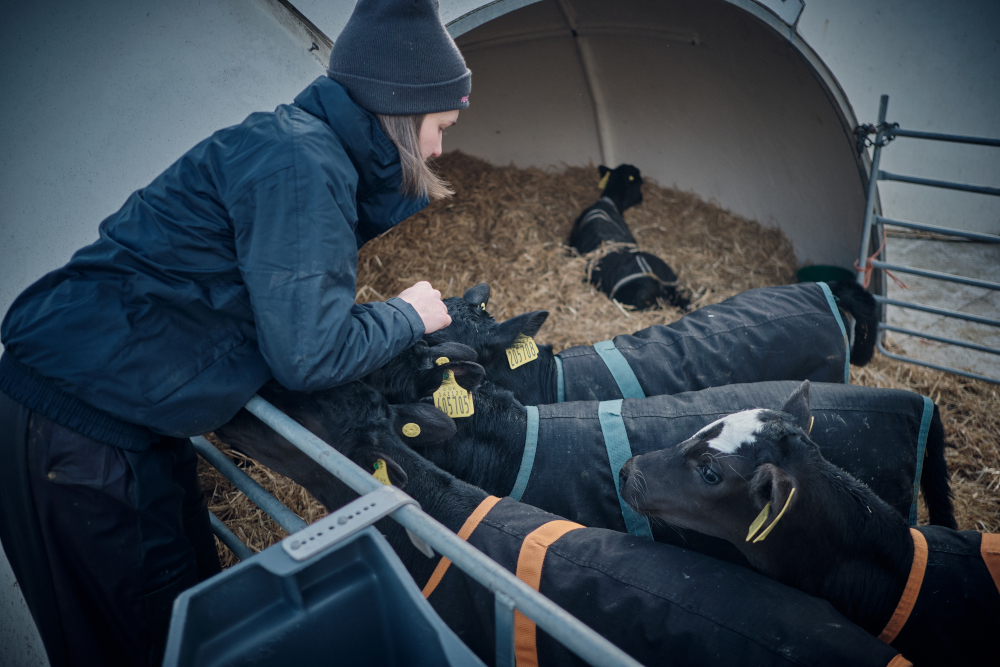Rearing the next generation: How one farm ensures rumen development and good calf health
Thursday, 10 April 2025
Ensuring that the next generation of the milking herd is reaching its genetic potential starts with calf rearing – encouraging calf health and rumen development. We explore the calf rearing system in place at Curtis Hulme Farm, one of our Strategic Dairy Farms.
The rumen must develop before a calf can properly digest forage, and with early stimulation, it can begin functioning as soon as five days after birth. Rearing healthy calves has been linked to having a healthier cow throughout their lactations.
Caroline Williams, one of the farmers at Curtis Hulme Farm, trained and practised as a vet for many years, so has the knowledge and expertise to rear calves to a high standard.
The calves at this farm are reared up to weaning, then contract reared until in-calf.
Caroline said:
"The team rearing calves consists of a full-time calf rearer, a part-time weekend calf rearer and myself. I feed calves every Monday and whenever needed."
Protocols for calf rearing
At Curtis Hulme Farm, a well-structured calf rearing system ensures consistency and high standards of care.
In order to offer the best care to their calves, this farm, like many others, has set protocols in place.
Caroline said:
"Everyone in the team follows the same thorough cleaning protocols. We keep detailed records on each calf to ensure information is shared with the rearing team and kept as a record.”
The team has a file of records, with a page per calf – including details of weights, treatments, etc. The treatments are also written on a whiteboard alongside key notes on calves.
The protocol for newborn heifers is carefully designed to ensure their health and development.
Within 30 minutes to an hour after birth, the calf is taken to its calf shed. The calf’s navel is sprayed with iodine to prevent infection and is then dipped or sprayed at each of the first four feedings to reduce the risk of navel ill.
The calf receives four litres of high-quality, Brix-tested colostrum, preferably by bottle. Whenever possible, colostrum from the dam is used, but if this cannot be done, frozen colostrum is fed to the calf.
The second and third feedings consist of another three to four litres of colostrum from the dam.
By the fourth feeding, the calf is transitioned to a mix of half colostrum and half RS Energy Advance milk replacer.
All calves are paired at birth, while beef calves follow the same protocol except that they transition to whole milk instead of milk replacer.
During the winter months, coats are placed on the calves at birth for warmth. Fresh water and Aston Rearer HJ Lea calf nuts are available from birth, and chopped straw is introduced after a few days.
Caroline added:
"By the fifth feeding, the calf is fully on milk replacer, initially fed in individual buckets until about a week old, when it moves to an automatic feeder. The feeding volume is gradually increased to four litres every twelve hours by two weeks of age, and the weaning process begins at 60 days.
"We vaccinate our calves. An intranasal vaccine is administered at around seven days old, depending on when a group of five calves reaches the appropriate age for a five-dose bottle. We also give the Respi3 vaccine at 7 and 10 weeks of age. Both help to build up immunity of diseases in the calves. Rotavec Corona or bovigen scour is also given to dry cows pre-calving to offer extra scours protection. Scours is largely prevented by ensuring calves receive high-quality colostrum in sufficient amounts.
"There are very few Johne’s dairy calves born on the farm, but when they are, they are fed frozen colostrum from clean cows to minimize the risk of infection. We do not separate these calves because we haven't got the space. They are always recorded as a Johne’s risk and are exclusively served to beef to prevent transmission within the herd."

The future of calf rearing
Caroline explained:
"There's always room for improvement. We still see cases of pneumonia, so I'd like to reduce that. There's also a lot of manual work involved which we could look at reducing."
Another area Caroline would like to work on as part of our Strategic Dairy Farm programme is implementing more lean management, like weighing calves during vaccination rather than at a separate time, helping to streamline some of their processes.
Caroline’s top tips for good calf health:
- Keep a record of calf weights, treatments, etc – this is good for sharing information and keeping a log of any issues
- Create a standard process for everyone in the team to follow – this will help ensure each calf has the same high-quality of care from cleaning and bedding down, through to feeding and weaning
- Look at colostrum quality – try and give your calves the best-quality colostrum as possible particularly for their first feed
- Do not wean your calves too soon – this will potentially affect their rumen development
About Curtis Hulme Farm
David and Caroline Williams manage a herd of 450 cows using an all year-round calving system. Their cows are a three-way cross of Holstein-Friesian, Norwegian Red and Montbeliarde, producing an average yield of 8,600 litres per cow at 4.2% butterfat and 3.4% protein. Their farm spans 540 acres, 240 of which are owned and the rest rented, or contract farmed. They grow maize, wheat, barley and grass with clover leys.
Through joining the Strategic Dairy Farm programme, David and Caroline want to look at soil mapping on their farm and increase herd productivity, with the feedback from a steering group and local farmers that they will be hosting during their on-farm meetings.

